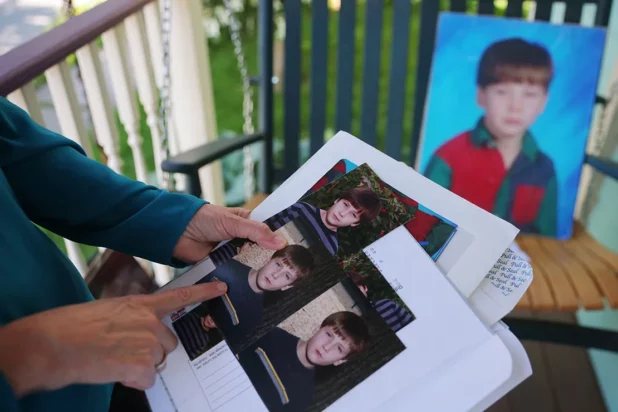Merck’s asthma medicine Singulair has been linked for years to suicides and psychiatric problems, often in children. But lawsuits over the drug are stymied by one of Corporate America’s most effective liability shields: the doctrine of federal preemptionhttps://t.co/MjpAS5XRr6 pic.twitter.com/qluWrBvFIH
— Reuters Legal (@ReutersLegal) June 26, 2023
This is a 4,000+ words Reuters special report.
I’ll try to edit it down for you, but there are several juicy bits.
Nicholas England, a healthy 22-year-old from Virginia, shot himself in the head in 2017, less than two weeks after he started taking an allergy medicine that had been linked for years to episodes of depression and suicidal thinking.
His parents soon started exploring a lawsuit against Merck, the developer of the blockbuster asthma and allergy drug, Singulair, along with the manufacturer of the generic version their son took. Nicholas had no history of mental-health problems, they said.
The Englands were shocked to learn from legal advisers that they had no case. Like countless other potential plaintiffs, they had run into one of Corporate America’s most effective liability shields: the legal doctrine of preemption, the principle that federal law supersedes state law.
Nicholas England
Armed with U.S. Supreme Court rulings on preemption starting in the 1990s, companies increasingly argue that federally regulated products or services should be immune from lawsuits alleging state-law violations. In a new reading of an old constitutional principle, judges have held that federal law, including the decisions of U.S. regulatory agencies, should preempt, or override, state statutes that seek to hold companies accountable for harming consumers.
State laws historically have provided the legal basis for some of the most common lawsuits against U.S. companies alleging injuries, deaths or illnesses caused by negligence or defective products.
These legal dynamics left the England family with no legal remedy at all. A pair of U.S. Supreme Court rulings, in 2011 and 2013, essentially barred lawsuits against generic drugmakers based on state laws that enabled claims over design defects or a failure to warn consumers of potential dangers. The court’s reasoning: Such claims were preempted by federal regulations preventing generic drugmakers, when copying name-brand drugs, from changing the formulation or the warning label.
That meant Merck had written the warning label, with federal approval, on the generic version of Singulair that Nicholas England took. But his parents couldn’t sue Merck, either, because their son had never taken its name-brand version of Singulair.
“The emotion of losing your child is so difficult on its own,” said Jennifer England, Nicholas’s mother. “It is very frustrating to realize that’s a loophole. I’m a small person in southwestern Virginia, and that’s a loophole there to protect companies much bigger than we could fight.”
Merck declined to comment for this report, referring all questions to Organon, a Merck spinoff created in 2021 that now markets Singulair. Organon declined to answer detailed questions from Reuters but said in a statement that it’s confident doctors and patients have gotten “complete and appropriate information” on Singulair’s safety. The generic drug manufacturer that made the pills England took, Teva Pharmaceuticals, did not respond to inquiries.
Corporate preemption defenses have proved broadly effective, according to a Reuters analysis of court cases and dozens of interviews with attorneys, legal scholars and plaintiffs or potential plaintiffs affected by preemption rulings. The analysis of federal appeals and Supreme Court rulings involving preemption found that judges ruled two-thirds of the time to weaken or kill lawsuits alleging deaths or injuries caused by corporate negligence or defective products.
Preemption defenses often deliver companies a swift procedural win, allowing them to avoid addressing the substance of plaintiffs’ allegations. It has been used across a range of federally regulated sectors, from railroads to agricultural chemicals to airlines and automobiles, the Reuters review found.
The preemption defense has had a particularly profound impact in the pharmaceutical industry, the review showed. The high court’s ban on certain lawsuits against generic drug manufacturers has extraordinary reach because generics account for 91% of U.S. prescriptions, according to data from the U.S. Food and Drug Administration (FDA).
Name-brand drugmakers can still be sued, but preemption defenses can make it much harder for plaintiffs to prevail, drug-industry litigation experts said. In many product-liability cases, plaintiffs must prove simply that a company’s product was unsafe. Those facing drugmakers’ preemption defenses must often demonstrate that a company failed to disclose safety information to federal regulators – and that the information could have spurred new government restrictions or warnings before the alleged harm occurred.
Pending lawsuits against Merck allege that the company’s own early research indicated the drug could impact the brain but that Merck downplayed any risks in statements to regulators.
England’s family had hoped to force executives from Merck and the generic manufacturer to reveal what they knew, and when, about the drug’s dangers. In the decade before England’s death, the FDA received more than 4,800 reports of patients, including many children, experiencing depression, suicidal thoughts or other psychiatric problems after taking Singulair or a generic version, according to a Reuters review of FDA data.
But it wasn’t until 2020 that the FDA slapped its most serious warning, called a “black box,” on the drug’s label. By that time, the FDA had received more than 80 reports of suicides in people taking the medicine.
Narratives included in reports to the FDA of suicides associated with Merck’s asthma and allergy drug, Singulair, or generic versions. The agency logged the incidents in its “adverse event” database, which tracks potentially problematic drug side effects.
Singulair, one of the best-selling drugs in U.S. history, has provided Merck with about $50 billion in revenue, company disclosures show. Since Merck’s patent on Singulair expired in 2012, major generic drug manufacturers have sold millions of prescriptions under the drug’s scientific name, montelukast.
The FDA said in a statement that it has “diligently monitored reports of side effects possibly associated with montelukast, as well as communicated findings and taken regulatory action, when appropriate.” The agency said it “continues to monitor and investigate this important issue.”
The FDA declined to comment on how modern preemption defenses and court rulings have impacted pharmaceutical regulation and litigation.
The doctrine of preemption is based on the U.S. Constitution’s supremacy clause. The original intent: to resolve conflicts between federal and state statutes and discourage state legislatures from passing laws that undermine federal policy.
Preemption-based corporate defenses are a modern phenomenon. American courts have historically viewed product-liability lawsuits, largely based on state laws, as vital to holding companies accountable when federal laws and regulations fail to do so. Courts recognized drugmaker liability for harmful medicines as early as the 1850s, according to a Supreme Court filing. FDA regulations once routinely specified that its decisions had no impact on drugmakers’ liability.
That started to change in 1992, in a case involving a smoker who died of cancer. The Supreme Court ruled that federal requirements for cigarette labels, which had included smoking warnings since the 1960s, overrode some of her family’s state-law claims that a tobacco company failed to warn her about smoking hazards.
States ultimately used different theories to force Big Tobacco into a $246 billion settlement. Still, the precedent gave Corporate America a blueprint for defeating similar lawsuits on preemption grounds.
Corporations got more help in the political arena. U.S. President George W. Bush had promised in his 2000 campaign to attack what Republicans derided as frivolous litigation targeting American industry. Administration officials undertook what critics dubbed “stealth” tort reform: intervening in lawsuits on the side of corporate defendants, with the goal of convincing judges to set precedents making it harder to sue companies.
Bush’s FDA exemplified the tactic. Daniel Troy, the agency’s chief counsel, interpreted preemption to mean that courts can’t undermine federal regulators based on alleged state-law violations. He aimed to make that argument in high-profile lawsuits. At a 2003 conference, Troy invited an audience of drug-industry lawyers to pitch the FDA on intervening in their cases.
“We can’t afford to get involved in every case – we have to pick our shots,” he told the assembled lawyers. “So make it sound like a Hollywood pitch.”
Troy, now a veteran pharmaceutical industry lawyer himself, said his goal at the time was simply to defend and strengthen the FDA’s authority to regulate without interference.
“If you believe in a strong FDA,” he said, “we can’t have state courts, especially juries, second-guessing and undercutting the FDA’s judgments.”
The FDA formally changed its view of preemption in a 2006 regulation, stating the agency now believed that FDA labeling approval “preempts conflicting or contrary State law.”
In its statement to Reuters, the FDA declined to comment on the 2006 regulation or the agency’s current view of preemption.
…
Preemption defenses rely in part on the notion that state laws are not needed to protect citizens who are already safeguarded by federal regulators. But in the case of Singulair’s potentially deadly side effects, the FDA waited years, despite thousands of reported psychiatric problems, to require its most serious warning on the drug’s label.
By the time Nicholas England killed himself, the FDA had been reviewing Merck’s disclosures about health risks for nearly two decades. Parents who argue Singulair endangered their children view the FDA’s 2020 decision to add a black box warning as vindication, but many still want to sue Merck for not acting sooner.
In the years after Singulair’s 1998 launch, reports of related neuropsychiatric episodes piled up on internet forums and in the FDA’s early-warning detection system. The system compiles reports of “adverse events” from patients, doctors and others to track potential dangers discovered after a drug hits the market.
Jan Gilpin’s son was first prescribed Singulair for asthma in 2003, at age three. The boy soon seemed withdrawn and sullen. He would sometimes go “into a strange trance, mumbling to himself,” Gilpin wrote in 2008 in a report to the FDA. “Worst of all, he started talking about death – wanting to die, wishing he was dead, saying that he hated himself.”
Jan Gilpin points to photographs of her son while he was taking the drug Singulair to treat his asthma
Gilpin didn’t suspect Singulair for more than three years. In 2007, she stopped giving her son the drug after she stumbled on parents’ online posts about their children experiencing social anxiety while taking the medicine.
Soon, she noticed he began to skip and laugh.
“I realized he hadn’t laughed in two years,” said Gilpin, speaking through tears. “I didn’t realize that I was poisoning him with this medicine.”
The boy’s obsessive thoughts about death disappeared after he quit the medicine, Gilpin said, but he seemed to have some lingering effects, such as anxiety, that took longer to go away.
In August 2007, a 15-year-old boy in New York killed himself 17 days after first taking Singulair. Two months later, Merck proposed, and the FDA agreed, to amend Singulair’s label to add suicidal thinking and behavior to a list of adverse events reported to the company.
But the mention of suicidal thinking appeared in the middle of a list of more than three dozen side effects. Parent advocates argue the new label was grossly inadequate to warn of such a grave risk.
Three weeks after proposing the label change, Merck asked the FDA about getting permission to sell Singulair over-the-counter, without a prescription, for adults with hay fever. The FDA agreed to consider it but also wanted to understand more about suicide risks. A 2008 FDA review of the drug’s psychiatric affects and suicide risks recommended “further studies in animals and humans” and suggested the agency consider asking Merck to conduct an observational study.
The FDA did not require such a study, reasoning in part that serious side effects including suicidal thinking “were expected to be quite rare.”
In 2011, the agency rejected a petition from Gilpin and other parents seeking a black box warning, citing what it called insufficient evidence that the drug caused suicidal behavior.
It’s not clear if this is the kind of society that either Republican or Democrat voters wanted, but it is clear that this is the kind of society both parties were intent on delivering.
Everyone has mysterious chronic health problems that mysteriously track with a mysterious regimen of mysterious vaccinations, and the mysterious drugs given to you to treat these mysterious chronic health problems mysteriously drive you to suicide.
Everyone is also mysteriously poor and gay.
Everything is very mysterious.
No one can figure out what is going on.

 Daily Stormer The Most Censored Publication in History
Daily Stormer The Most Censored Publication in History





